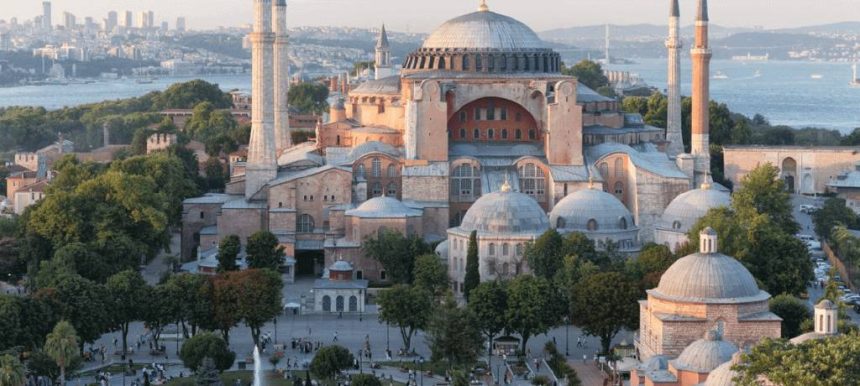There are a few cities in the world whose history is as long and storied as Istanbul’s. For a long period, it was the most important city in the world laying at the crossroads between East and West.
It sat at the heart of two empires and was coveted by many others. It was conquered, fought over, and rebuilt several times before becoming the cosmopolitan city it is today. It’s a city that has gone by many names, Byzantium, Tsargard, Miklagard, and perhaps the most famous of all Constantinople. We went back in time to see how Constantinople came to be and how it developed into Istanbul.
Byzas the Megarian named the city Byzantine in 700 BC, and until 300 BC, the town was occupied by a small Greek colony. For the next 1,000 years, Byzantine flourished as a trade and commercial center, attracting the attention of the Roman Empire, which invaded the city in 193 AD and proceeded to use it as a trading hub. When Roman Emperor Constantine left Rome in the fourth century, he considered Istanbul to be the best city in the world.

The city was a perfect example of strategic advantage, with its seven hills, control of the Bosphorus, and convenient access to the Golden Horn harbor. It was revamped and expanded as the empire’s new capital, and new temples, official buildings, palaces, hamams, and the hippodrome were constructed.
With an official ceremony in 330 AD, the city was proclaimed the capital of the Eastern Roman Empire and dubbed Constantinople. Constantinople was the capital for several centuries, with a golden era under Emperor Justinian in the sixth century.
Justinian the first, built a huge Church the Hagia Sophia in 537 AD. It was the largest building in the world and an engineering marvel of its time. Istanbul or Constantinople, as it was called then was the last stronghold of the Roman Empire, a huge fortified city with thick stone walls. As the Roman Empire shrunk and lost territory a stronger Empire emerged the Ottoman Empire that slowly surrounded Constantinople. Emperor Constantine XI ruler of Constantinople couldn’t do anything to stop them. In 1453 AD Sultan Mehmed II led the Ottoman army just outside the walls of the city, they laid siege to the city and cut off the supply routes.

Constantinople was heavily outnumbered and in deep trouble. To take over, the Ottomans had to find a way to break through the huge thick walls so Sultan Mehmed hired a mysterious arms dealer to build him a massive cannon. The supergun was able to hurl a six hundred-pound stone ball over a mile. Sultan Mehmed hauled his new cannon down to the walls of Constantinople. Each blast tore through the heavy stone walls. It took three hours to reload but blast by blast they destroyed the walls. The Ottoman army poured in through the breach the walls and met at the vast square in front of the Hagia Sofia when Sultan Mehmed II got to the church he declared that it would immediately be converted to a mosque, the center of worship for his religion Islam. They recited a prayer in the church to convert it to a mosque. Minarets, prayer call towers, and Islamic art were added over the next years. It remained a mosque until it was converted to a museum in 1935 by Mustafa Kamal Ata Turk, however, after 86 years, in July 2020, Turkish President Erdogan converted it back to a mosque.

Under the Ottoman rule, the city saw a rise in population with Greek, Armenian, and Jewish immigrants enjoying religious freedom and social rights. Out of all the Ottoman leaders, it was Süleyman the Magnificent (1520-66) whose military conquests brought wealth to Istanbul, which resulted in the glorious works of famous architect Mimar Sinan.
The Ottoman Empire rolled on for hundreds of years the name Constantinople slowly changed to Istanbul over time, and was officially changed in 1930 by Mustafa Kamal Ata Turk. The Ottoman Empire fought on the losing side of World War One. After they lost, the Empire turned into the modern-day country of Turkey and became a republic and a democracy.
Mustafa Kemal the first president of the New Republic of Turkey wanted to draw a line between the old order and the new. As a first step, he formally changing the name of Constantinople to Istanbul to match what it was already called by the Turkish people. He asked that all the nations respect this change and start calling the Turkish capital Istanbul from then on, however, they did not. Most major European nations kept calling at what they had done previously. Out of the world’s major powers, it was only the United States that acknowledged the change. So the Turkish now had some difficulty, so to force the issue in 1930 Turkey passed a new postal law which forbid the postal service from delivering letters addressed to Constantinople and this worked which is why most nations officially refer to the city as Istanbul now.
Thus the historic city bridging the east and the west, today is called Istanbul. Today, the huge modern city bustles with rich history making it a huge attraction for travelers, historians alike.







